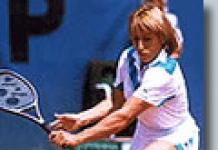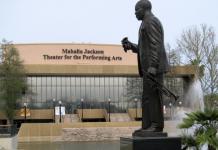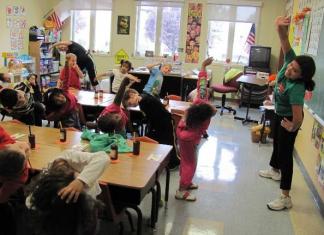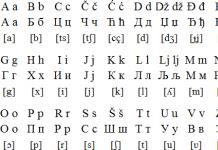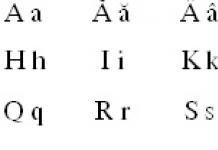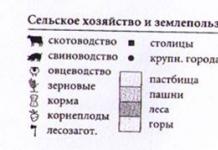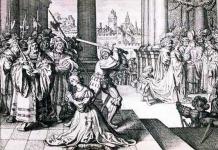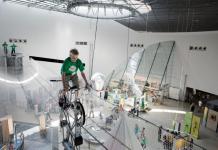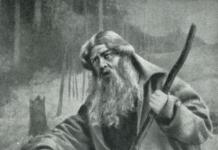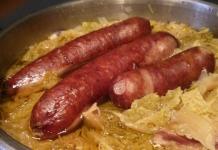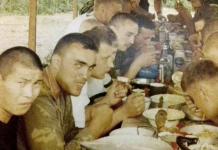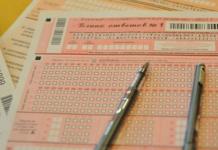And they can find an individual approach to the child in each individual case. Parents do not have such skills and knowledge, so they often make mistakes when organizing the process of learning to read on their own, without prior preparation or consultation. Based on my many years of experience in elementary grades, I want to point out the main problems that arise if you do not know how to properly teach a child to read by syllables.
The main mistake that is difficult to correct is letter-by-letter reading. Parents believe that letters are the main unit of reading and teach the child to first name the letters, and then try to combine them into a whole word. Even worse, if at the same time they practice using the full names of letters (“em”, “pe”, etc.) or do not correct the baby when he pronounces “we”, “py”, naming consonant sounds.
This approach is fundamentally wrong: with such training, the child does not master the mechanism of sound-letter fusion of a syllable, he learns to read only on the basis of memorizing and reproducing verbal formulations (such as “el” and “a” will be “la”), and this significantly slows down reading speed, the child often confuses syllables and makes mistakes.
To wean a "taught" child from using such an algorithm, it will take at least 4 - 6 months for retraining. Even when the teacher is able to explain and show the child that it is not necessary to pronounce such formulas, but the whole syllable should be immediately called, the child will continue to do as before “in the mind” and only then pronounce the resulting combination.
One more problem - poorly developed phonemic awareness. Parents generally do not tend to pay attention to the use of various phonemic exercises. Therefore, it is only at school that a child begins to get acquainted with the concept of sound, to learn to distinguish it in a speech stream, to determine its place in a word. But it is precisely the stable association “letter = sound” that is the basis for continuous reading and competent spelling. Particularly serious problems arise when studying the letters "s", "i", "u", "e", "e", as well as the signs "b", "b", because their use is based only on the ability to determine what sounds they denote (or share) in a particular position.
It should also not be forgotten that often parents achieve results due to persistence and constant demands on the child because they do not know a wide range of didactic games and exercises. Therefore, a preschooler can quickly lose interest in reading and perceive this process as a boring “obligation”.
To avoid all the mistakes described and teach the child to read correctly, we suggest that parents use our recommendations below.
Methodological foundations for teaching reading by syllables
Pedagogy describes several ways to teach a child to read. The most effective is the method of reading by syllables, which is based on a sound-letter approach. At the same time, syllables are the main "bricks" from which the word is composed. Consider how to teach a child to read by syllables at home.
So, first you need to introduce the child to the basic vowel sounds and the letters they are denoted by: “a”, “o”, “y”. Each letter should be given 2-3 lessons. The algorithm for studying these and subsequent letters is as follows.
Stage #1 Motivation
The lesson should begin with a game moment that will arouse the child's interest in what will happen. You can show him a toy or a cartoon frame, let him listen to a song, etc. Your task is to draw the attention of the baby to a specific subject. For instance:
- treat the child with an orange;
- give a cartoon about a donkey;
- show the duck and let it swim in the bowl.
After such an action, ask the baby a question (what did he eat, what did he play with, etc.), and then ask him to repeat the name of the object again.
Stage number 2. Getting to know sound
Next, you need to highlight the first sound in the word. To do this, say the word and stretch the first sound, pronounce it louder and more clearly than others. Have your child repeat after you. He must determine and name the first sound in the word he heard.
Now we need to play with this sound:
- pronounce with different voice strengths (quieter - louder);
- sing;
- speak with different intonation.
It is important to pay attention to the articulation of sound. Be sure to talk to your child how it turns out to pronounce this sound, in what position are the lips, teeth and tongue. To do this, invite him to observe you or look in the mirror at yourself. When studying vowel sounds, it is recommended to show the baby the appropriate demonstration pictures.
Games for the development of phonetic hearing
When you have already learned several sounds with your child, be sure to play the “Guess the sound” game with him - by the position of the organs of articulation, he must guess what sound you are going to pronounce.
After such games, offer your child other exercises to develop phonetic hearing:
- Name words that also begin with the desired sound.
- “Catch the sound” - the adult must pronounce different words, and the baby repeats them, and if he hears the indicated sound in it, he claps his hands.
- “Sat in the house” - make a cardboard house template with 3-4 windows and invite the child to place pictures in them with those objects whose name begins with the desired sound.
- “Say the word” - you name part of the word, and the child must say it in full, adding a sound at the beginning (at the end) of the word.
Attention! No need to use more than 2 exercises in one lesson.
Stage number 3. Getting to know the letter
Now it's time to learn the letter. To do this, you can invite the child to find the desired picture among the cubes or on the alphabet (for example, an orange). It should be explained that since the name of this object begins with the sound [a], a letter was written next to it, which denotes this sound.
Examples:
- Cubes Myakishi "ABC in pictures" in the store OZON.ru.
- Educational wooden toys Cubes Alphabet.
- Cubes "ABC", 12 pcs.
Invite the child to carefully consider the letter, determine what parts it consists of (sticks, ovals, hooks). Discuss with him what the letter looks like. It is recommended to use special pictures in which the letter is depicted as a real object. If possible, you can create such pictures yourself directly during the lesson. The child will be very interested in watching the transformation of the letter.
You also need to ask the baby to write a letter. This can be done in different ways:
- draw with chalk on the board;
- write with your finger in the sand;
- mold from plasticine;
- lay out with buttons;
- twist from wire, etc.

Such exercises will really please the child and will allow you to better remember the letter.
Stage number 4. Composing a syllable
When the baby learns the first three vowel sounds, each subsequent sound (after getting acquainted with the letter) is immediately included in the syllables. The main thing is to explain it in such a way that the child understands the very mechanism of merging two sounds into one single syllable. The adult should show two letters and say that now he will pronounce them together, without stopping and separating.
For an additional effect, you can add visualization:
- put two cubes side by side;
- write letters on the details of the designer and connect them together;
- put the letters in one house, etc.
Having shown a syllable to a child, an adult should pronounce it clearly and drawlingly, and then ask the child to repeat it. Next, it should be explained in words that in order to pronounce the syllable “ma”, you must first close your lips for the sound [m] and immediately open your mouth and round your lips to pronounce the sound [a]. It is recommended to demonstrate this process several times, inviting the child to do the same.
As practice shows, such detailed explanations and training will be needed only for the first 1-2 weeks of syllabic reading classes. As soon as the child understands and learns the principle of combining sounds into syllables, he will easily do this in any combination.
In addition to learning to read direct syllables (consonant + vowel), you need to offer him to read reverse (vowel + consonant) and complex (2-3 consonants + vowel) syllables. The methodology is similar: demonstrate a sample, analyze articulation and perform training exercises.
Reading in syllables
The presented method of how to teach a child to read by syllables is suitable for homework with a baby from 5 years old. After 2-3 weeks of classes, the child will be able to independently, looking at the written letters, name the syllable. There is no need to rush him, however, if he finds it difficult to pronounce a syllable after 30 - 60 seconds, you need to prompt him, help him compose a syllable. This should be done in a friendly manner, without irritation and reproaches.
When the child makes the first syllables "ma", "mu", it's time to show that by combining some syllables together, you can get a whole word. It is better to explain this using syllabic cubes (you can buy a special set or make them yourself) or designer parts. The main thing is to show that in order to read a word, you need to name syllables and then combine them. Be sure to ask your child what the word is and what it means.
In the future, when it will no longer be necessary to spend a lot of time explaining all the described basics of reading by syllables, the main part of the classes should be devoted to training exercises. Practitioner teachers say that there is no other way to learn to read well, except for constant reading. The more often and more the child reads, the better he will get it. And so he needs to maintain a constant interest in reading classes. To do this, it is recommended to use a variety of didactic games.
Examples:
- speech therapy exercises.
- From playing to reading. Didactic exercises.
Didactic games for learning to read
Game "Sun"
The figure shows the sun with rays. The letter being studied is placed in the center, and the rest of the letters are placed at the ends of the rays. Moving from the center along the ray, you need to name the syllable that is obtained. You can also move in the opposite direction.
A similar game is called "Watch". The main letter is placed in the center of the hand, and the rest on the dial. By moving the arrow, we call the resulting syllable.
Game "Let's run along the path"
Pick up a picture with a short winding path. Place circles with printed syllables on it. The child receives a chip and begins to move it forward, naming syllables along the way. You can arrange a team game - who will go faster and not make a mistake.
Dice game
For cubes with syllables, you can come up with many tasks:
- read all the syllables on the cube;
- choose cubes to make a word;
- replace (add) one syllable in the composed word to get a new word;
- choose the syllable for the picture, which is the first in the name of the depicted object.
You can even just give the child a box with such cubes, and he can invent a way to play with them himself.
Syllable table
Make an interactive syllable table. It is made according to the principle of the Pythagorean table. Lines in the table need to be added as new letters are learned. Tasks for working with the table can be the following:
- find the indicated letter and read all the syllables with it;
- find the named syllable in the table;
- show the named syllables in the table and make a word out of them;
- draw rays between syllables to make a word.
Later you need to make another table, which will consist of complex syllables.
As a result of constant training exercises, the ability to name syllables will be brought to automatism, and from this the reading speed will increase significantly. However, parents need to remember that this is not the only criterion that is important for good reading. Attention should also be paid to the development of such reading characteristics as awareness and expressiveness, that is, we are already talking about.
Send your good work in the knowledge base is simple. Use the form below
Students, graduate students, young scientists who use the knowledge base in their studies and work will be very grateful to you.
Posted on http://www.allbest.ru/
Question 1. Formation of the correct reading of younger students
Interest in reading arises when the reader is fluent in conscious reading and has developed educational and cognitive motives for reading.
The condition for mastering reading activity is also knowledge of reading methods, methods of semantic text processing, possession of certain skills and abilities that should not develop spontaneously.
Reading is a complex psychophysiological process. Visual, speech-motor, speech-auditory analyzers take part in his act. On the basis of this process, as B.G. Ananiev, “the most complex mechanisms of interaction between analyzers and temporal connections of two signal systems” lie.
In the complex process of reading, three main points can be distinguished:
1. Perception of these words. To be able to read means, first of all, to be able to guess by letter the words that they denote. Reading begins only from the moment when a person, looking at the letters, is able to pronounce, or remember, a certain word corresponding to a combination of these letters.
It is not difficult to show that in this process of perceiving letters as symbols of a certain word, not only vision, but also the memory, imagination and mind of a person take a great part. When we read words, we not only add letter by letter, but, grabbing one or more letters, we immediately guess about the whole word.
2. Understanding the content associated with the words read. Each word we read can cause some changes in our minds, which determine our understanding of this word. In one case, a certain, more or less vivid image appears in our consciousness, in another - some kind of feeling, desire or abstract logical process, in the third, both together, in the fourth - no image and feeling, but only a simple repetition of a perceived word, or perhaps another word associated with it.
3. Evaluation of reading. The ability not only to read a book, but also to critically relate to its content is observed, as is well known, not always.
Reading is driven by need. A younger student who masters reading first has a need to learn to read, that is, to master the sound system and the process of reading itself - the emergence of a word from the letters. This piques his interest. Having mastered the initial reading (literacy), the student changes the motive for reading: he is interested in understanding what thought lies behind the words. As reading develops, the motives become more complex, and the student reads in order to find out some specific fact, phenomenon; even more complex needs appear, for example, to know the motive of the hero's act in order to evaluate it; find the main idea in a popular science text, etc. correct reading pronunciation violation
Reading is directly related to oral speech. With the help of oral speech, the expressiveness of reading is worked out; when reading, means of speech expressiveness are used, as well as coherent oral speech to convey the content of the text and communication between readers.
In order to form reading as an educational skill, this circumstance must be borne in mind. It is also important to take into account the peculiarities of the cognitive activity of children. Children of 6-7 years old have not yet developed logical thinking, it is visual and effective in nature, it requires reliance on practical actions with various objects and their substitutes - models. Further, thinking gradually acquires a visual-figurative character, and, finally, logical abstract thinking arises. These stages in the development of the cognitive activity of the younger student leave their mark on the nature of education.
The modern methodology understands the skill of reading as an automated skill for voicing printed text, which involves understanding the idea of a perceived work and developing one's own attitude to what is being read. In turn, such reading activity involves the ability to think about the text before reading, during reading and after reading. It is this kind of “thoughtful reading”, based on the perfect reading skill, that becomes a means of familiarizing the child with the cultural tradition, immersing himself in the world of literature, and developing his personality. At the same time, it is important to remember that the skill of reading is the key to successful learning both in primary and secondary schools, as well as a reliable means of orienting in the powerful flow of information that modern man has to face.
In the methodology, it is customary to characterize the skill of reading, naming its four qualities: correctness, fluency, consciousness and expressiveness.
Correctness is defined as fluent reading without distortion affecting the meaning of what is being read.
Fluency is the speed of reading, which determines reading comprehension. This speed is measured by the number of printed characters read per unit of time (usually the number of words per minute).
Consciousness of reading in the methodological literature of recent times is interpreted as understanding the author's intention, awareness of the artistic means that help to realize this intention, and understanding one's own attitude to what is read.
Expressiveness is the ability by means of oral speech to convey to the listeners the main idea of the work and their own attitude towards it.
All these qualities are interconnected and interdependent. Without the correct voicing of graphic signs, it is impossible to understand the individual units of the text, without understanding the meaning of each unit, it is impossible to understand their connection, and without the internal connection of the individual components of the text, the idea of the work will not be realized. In turn, understanding the general meaning of the work helps the correct reading of its individual elements, and the correct reading and understanding of the text become the basis for the expressiveness of reading. Fluency, being the pace of reading, under certain conditions becomes a means of expressiveness. Thus, the preparation of a reader should be built taking into account the simultaneous work on all four qualities of reading skills. This approach is being implemented already in the period of literacy education. It is even more important to keep such a system of work in mind in the classroom when reading literary texts.
Work on the correctness of reading is an important area of work on the formation of reading qualities.
Correct reading is reading without errors and distortions. At present, in the special methodological literature, the main techniques that contribute to the formation of the correct reading of students are highlighted. These include:
sound-letter analysis of words;
reading tables with difficult words;
preliminary syllable-by-syllable reading of words with a complex syllabic or morphemic composition;
Reading small texts that are not related to the work being studied in the class, written on the blackboard;
choral reading of the difficult part of the story;
distribution of parts of the text for reading between students, taking into account the capabilities of each;
Reading by guesswork
· training reading with tasks of a different nature (selective reading, finding a part of the text for an illustration, etc.).
However, these exercises do not always provide the formation of reading quality in full. Practitioners are well aware that even with systematic work on this quality of reading, children with intellectual disabilities make a number of mistakes: distorting the meaning of a word, replacing some words with others, not observing stress, sentence boundaries, repeating individual words and syllables, etc.
To develop correct reading, in addition to organizing everyday exercises, preventing errors, constant monitoring of the correct reading of students and timely correction of errors are necessary. Pay attention to the instructions for troubleshooting:
* the teacher fixes all the student's mistakes, but interrupts reading only when the error leads to a distortion of thought;
* errors in the end of words the teacher corrects himself, without interrupting the reading of the student;
* errors that distort the meaning of the sentences are corrected by re-reading the same place or by asking a question to the read passage.
Sometimes other students are involved in correcting a student's mistake.
It makes sense to talk about correctness as a quality of reading skill only if the reader understands the text that is being voiced by him. However, the teacher must know special techniques aimed at practicing correctness and fluency. There are two directions here:
1) the use of special training exercises that improve visual perception, the development of the articulatory apparatus, and the regulation of breathing;
2) application of the principle of multi-reading proposed by M.I. Omorokova and described by V.G. Goretsky, L.F. Klimanova.
This principle consists in the fact that, when analyzing a text, constantly turn the child to reread passages that are important in a semantic sense, and thereby not only ensure penetration into the idea of the work, but also achieve correct and fluent reading.
Long-term observations of the development of reading skills in children make it possible to single out several groups of typical mistakes made by learners to read.
1. Distortion of the sound-letter composition:
omissions of letters, syllables, words and even lines;
Permutation of reading units (letters, syllables, words);
insertion of arbitrary elements into reading units; - replacement of some reading units by others.
The reasons for such errors are the imperfection of visual perception or the underdevelopment of the articulatory apparatus. However, the so-called “guess reading” can also become a cause of distortion. This phenomenon is based on such a human property as anticipation - the ability to predict the meaning of a text that has not yet been read according to the meaning and style that is already known from the previous passage read. a guess appears in the reader with the acquisition of reading experience and is thus a sign of his progress in mastering the skill of reading. At the same time, the teacher must remember that the textual guess of an experienced reader rarely leads to errors that distort the meaning of what is being read, and the subjective guess of an inexperienced child often entails such errors that prevent him from understanding what he is reading.
2. The presence of repetitions.
Such errors consist in the repetition of reading units: letters, syllables, words, sentences. The less perfect the reading skill, the smaller the unit of reading is repeated. These errors are very close to the previous type, however, their causes are different. Repetitions, as a rule, are associated with the child's desire to keep the just read component in working memory. This is necessary for the little reader to comprehend what he read. Therefore, at the analytical stage of the formation of a skill, repetitions are inevitable and should be perceived by the teacher as a natural and even positive phenomenon. Excessive haste of the teacher, early suppression of "repetitions" in the reading of students can prevent the child from moving freely and naturally to the synthetic stage of reading.
3. Violation of the norms of literary pronunciation.
Among the errors of this type, one can, in turn, distinguish several groups:
1) errors proper pronunciation; among these, mis-emphasis is the most common kind. Such errors are associated with ignorance of the norms of pronunciation or with ignorance of the lexical meaning of the words that are read;
2) errors associated with the so-called "spelling reading":
Reading units are voiced in strict accordance with spelling, and not with pronunciation. The teacher should keep in mind that “spelling reading” is an obligatory period in the formation of a skill. The sooner the student learns to synthesize all the actions of the reading process (perception, pronunciation, comprehension), the sooner he will abandon “spelling reading”. Therefore, work that helps the child comprehend what is being read will also contribute to the elimination of “spelling reading”;
3) intonation errors, which are incorrect logical stresses, semantically inappropriate pauses. It is easy to see that such errors are made by the reader if he does not understand what is being read. However, the process of reading from a small child requires not only intellectual, but also physical efforts, therefore, intonation errors in a small reader can be caused by untrained breathing and speech apparatus.
The teacher can work correctly on correcting and preventing errors in reading only if he understands the reasons for erroneous reading and knows the methodology for working on errors. So, factors such as:
1) imperfection of visual perception;
2) underdevelopment (insufficient flexibility) of the articulatory apparatus;
C) shortness of breath;
4) ignorance of orthoepic norms;
5) ignorance of the lexical meaning of the word;
6) "guess" caused by subjective type of reading.
Various exercises can be used to develop correct reading:
Exercises for the formation of correct reading include several subgroups.
The first subgroup - exercises for the development of attention, memory.
1. Name the pictures - 5 items (the number is gradually increasing).
The pictures are on the board. They must be opened, counted to three, closed. List all items. Find what has changed, etc.
2. Describe the item (show and remove).
3. Repeat what the teacher said (six words are called in pairs that are similar in sound). A barrel is a point, a grandmother is a butterfly, a cat is a spoon.
4. Choose words with this sound (reading a quatrain, sentences, text).
5. Pick up the names of products for this sound, from which you can cook dinner.
6. Stand up those who have this sound in their first name, patronymic, last name.
7. Choose an object in the name of which the stress falls on the 1st syllable (2nd, 3rd) (show objects).
8. Choose words that have two syllables (one, three, etc.). Say 8-10 words.
9. Repeat tongue twister, sentence, text.
10. Learning quatrains.
The second subgroup - exercises with words.
1. Reading words that differ by one letter.
Chalk - stranded, soap - soap, small - crumpled. Mouse - midge - bear - bowl.
2. Reading words that have the same letters in their spelling.
Bush - knock, pine - pump, fur - laughter, mouse - reeds, brand - frame, march - scar, oil - resin, midge - chamomile.
3. Reading words that have the same prefixes, endings.
Came, came, sewed, brought, refrain; red, white, blue, black, yellow;
doll, mom, dad, paw, spoon.
4. Reading "shifters".
The lion ate the oxen. Go look for a taxi, go.
5. Dictionary work (finding out the lexical meaning of words before reading).
6. Preliminary syllabic reading of words that have a complex syllabic or morphemic composition.
Thus, the process of reading consists of two interrelated aspects - semantic and technical, covering the visual and sound-auditory-speech-motor mechanisms. And although this process is one, the formation and formation of its components proceeds in different ways, goes through a number of steps from initial to higher.
Question 2. Prepare an outline of a lesson in the Russian language in grade 3 "Noun"
Lesson objectives:
1. Form an initial idea of the declension of nouns; to acquaint students with the name of cases, six pairs of case questions, prepositions that are used with case questions.
2. Develop students' spelling vigilance.
3. To cultivate a culture of speech.
Lesson type: combined
During the classes
I. Organizational moment:
Now check it out buddy
Are you ready to start the lesson?
Everything is in place, everything is in order,
Pen, book and notebook.
Is everyone seated correctly?
Is everyone watching closely?
Is everyone ready to listen?
Think and remember?
II. Calligraphy.
III. Working on new material:
U. Guys, I will read you a fairy tale. You listen carefully, and then find in this tale the same noun, but with different endings. Do you know what an ending is?
(The ending is the part of the word that is at the end of the word and changes.)
W. That's right. Well, listen.
Once upon a time there was a yellow-eyed daisy. And she had a friend, a light-winged moth. They were very friendly with the moth. The girlfriend often thought of the moth when the moth was not around. And he did not forget the beautiful chamomile. He thought of chamomile in distant meadows and fragrant gardens. Returning from afar, he would certainly bring a gift to the chamomile: a delicate cobweb or a brilliant dewdrop. And the girlfriend, blooming with pleasure, handed the moth a drop of sweet nectar. The little traveler was very pleased with the chamomile and the treat. There was nothing more pleasant for a pretty chamomile than to feed a moth with nectar.
U. What two words are often found here (chamomile and moth)
Now let's write these words in a column and ask them questions.
U. What did you pay attention to when cheating?
(The form of the word changes.)
U. Why did you decide that this is a form of the word, and not related words?
(Only the ending changes.)
U. What is the purpose of the ending?
(Endings serve to connect words in a sentence..)
U. So, nouns change their endings when they appear in a sentence next to other words.
What two groups are nouns divided into?
(Inanimate and inanimate.)
Which nouns are animate and which are inanimate?
(We call animate nouns those that denote people and animals and answer the question WHO?)
U. Right! So, the following questions can be posed to animated nouns: WHO? WHOM? TO WHOM? BY WHOM? ABOUT COM?
Questions about inanimate nouns are: WHAT? WHAT? WHAT? HOW? ABOUT WHAT?
U. What kind of work did you and I do?
(Changed nouns for questions.)
At . How many of you know what one word can replace this long phrase?
(Children's answers are heard.)
U. Changing nouns in questions is called declension or change in cases.)
Read the definition of "declination".
U. There are 6 cases in Russian: nominative, genitive, dative, accusative, instrumental, prepositional.
In the nominative case there are nouns that answer the questions WHO? WHAT? (chamomile, moth), in the genitive - nouns that answer the questions WHO? WHAT? (chamomile, moth), in the dative - nouns that answer the questions TO WHOM? WHAT? (chamomile, moth), in the accusative - those that answer the questions of WHO? WHAT? (chamomile, moth), in the creative there are nouns that answer the questions WHO? HOW? (chamomile, moth), questions of the prepositional case - ABOUT WHOM? ABOUT WHAT? (about a camomile, about a moth).
But why did the cases get such names? To get an answer to this question, you must listen to a fairy tale
“Where did the names of cases come from” E. Merezhinskaya
He had not yet been born, but they were already thinking what name to give him, and decided to name him - nominative, from the word name.
Born - became parent. He liked this name even more.
But he was a baby, everything was given to him, and he became a giver. But he was also a big mischief-maker, for all sorts of tricks he was blamed, and he became accusatory.
Then he grew up, began to do good deeds and became called creative. He offered his help to everyone, they started talking about him and now they called him prepositional.
Cases were once asked:
Why do you need a noun?
It's impossible without us. We indicate the relation of our Noun host to other words in the sentence.
How exactly?
We indicate the relationship between action and place (walking through the forest, sitting on a chair), action and tools (beat with a hammer, draw with a pencil), action and object (read a book, pick berries) And so on.
U. And now let's write in the columns in order the names of the cases and the questions to them, which turned out when the words were declensed butterfly and chamomile.
To find out the case of a noun (if it is not the subject), you need to find the word on which it depends, and put a question to the noun from this word.
For instance,
carry (to whom?) grandmother,
remember (about whom?) about the puppy,
hung (on what?) on the wall.
(Children, under the guidance of a teacher, write down cases and questions to them in a table.)
IV. Fizminutka:
U. The noun in the nominative case is the easiest to recognize. In a sentence, it is the subject. Nouns in all other cases will be other members of the sentence.
What is the subject?
(This is the main member of the sentence, which names the person (or what) the sentence is talking about. Children give examples of nouns in the nominative case.)
U. Guys, a lot of people, in order to make it easier to decline a word, use helper words. These helper words are friends with cases.
(A table is posted on the board, which hangs in subsequent lessons for a more solid assimilation of cases and case questions).
U. I will now read you verses where there are many words in various cases. By memorizing these verses, you will quickly remember the cases.
The twist of fate is so amazing:
We are studying the NOMINAL case.
Hanging on a bitch (what?) - cheesecake!
Sleeping on the fence (who?) - old lady!
From the sky it flies to us (what?) - toy!
Nightingale whistles (who?) - girlfriend!
On a pine tree snores (who?) - pig!
Told everyone (who?) - liar!
They created such an amazing world!
Well, let's remember the nominative case!
U. What case is the poem about? What question do nouns in the nominative case answer? ( Children give answers)
I AM from home ran away,
I AM until the evening walked.
from the tree in a snowdrift sigal,
No lessons dreamed of living.
For a collection snowflakes
I collected with my tongue.
Dancing around the fire
And jumped around the yard.
Do I need to do lessons?
I didn't care!
Here I stand at the blackboard
And I sigh in anguish
But the GENITAL case
I don't remember, even cut it!
U. What case is this poem about? What question do nouns in the genitive case answer? ( Children give answers)
V. Consolidation of new material. Independent work.
Make a table.
Using the compiled table, the children conclude:
What do we call inclination?
How many cases are there in Russian?
What case do the nouns in the initial form belong to?
Name the questions of indirect cases.
VI. Vocabulary work. Vocabulary work:
U. Determine in which case are nouns?
In the language, without a teacher, from a student, along the street, behind a tractor, on machine tools, in front of straw, from the north, across the Motherland, in drawings, with children.
U. In what number can nouns be inflected? (Both plural and singular.)
VII. Homework:
Ex. 96; learn the definitions of the concepts of declension, questions of cases p.83
VIII. Lesson Summary:
What did you do in class?
What have you learned?
What is the initial form of a noun in a sentence?
How many of you have difficulty in declension of nouns?
List of used literature
1. Klimanov, L. Learning to read in elementary grades / L. Klimanova // School. - 1999. - No. 18. - S.15-16.
2. Lvov, M.R., Goretsky, V.G. Methods of teaching the Russian language in primary classes / M.R. Lvov, V.G. Goretsky. - M.: 2000. -145s.
3. Omorokova, M.I. Improving the reading of younger schoolchildren / M.I. Omorokova. - M., 1997. - 116s.
4. Svetlovskaya, N.N. Reading Teaching Methods: What is it? / N.N. Svetlovskaya // Primary school. -2005. -#2. -p.34-36.
Hosted on Allbest.ru
...Similar Documents
Psychophysiological structure of the reading process and methods of teaching it. Psychological and pedagogical characteristics of younger schoolchildren with speech disorders. Diagnosis of the formation of the skill of correct reading in children with OHP, exercises for its development.
term paper, added 08/13/2013
term paper, added 03/12/2017
The goals of teaching a foreign language, set for younger students. Psychological features of younger schoolchildren and the formation of reading skills. Requirements for the organization of the process of teaching reading. Examples of exercises for teaching reading technique.
abstract, added 01/06/2011
Introduction of younger schoolchildren to literature. The system of work on the development of independent reading activity of younger students. Techniques and methods for developing interest in reading at the lessons of literary reading. The effectiveness of literary education.
abstract, added 03/03/2011
Essence and tasks of moral education of junior schoolchildren. Criteria and levels of formation of moral qualities of children. Guidelines for organizing literary reading lessons for the development of moral qualities in younger schoolchildren.
thesis, added 12/03/2013
Theoretical foundations of teaching younger students to understand the text. Working with him in elementary school. Teaching children to voice and comprehend a literary text. Speech therapy methods for conducting reading classes. Analysis of the content of the work.
term paper, added 02/26/2014
Analysis of the specifics of the formation of students' cognitive interest in reading lessons. Peculiarities of children's reading activity. Methodological development for the development of interest in reading among younger students. A selection of books for children to read on their own.
thesis, added 11/13/2015
Analysis of the literature on the problem of the development of speech of younger schoolchildren in the lessons of literary reading. Conducting a formative experiment. Evaluation of the effectiveness of methods for the formation of the ability to perceive others and express their thoughts orally and in writing.
thesis, added 06/28/2015
Scientific-theoretical, anatomical-physiological and psychological foundations of the reading process, psychological analysis of errors. Organization and methods of studying reading disorders in younger schoolchildren. Methodological recommendations for improving reading.
term paper, added 02/18/2011
Psychological and pedagogical essence of the concepts "creative abilities", "creative activity" of junior schoolchildren. Organization of creative activity of younger schoolchildren at the lessons of literary reading. Methods of using theatricalization in the classroom.
2016
Correct reading - this is reading without distorting the sound composition of words, observing the correct stress in words.
stands outfour qualities reading skill:correctness, fluency, consciousness, expressiveness.
Formation of the skill of correct reading
One of the most effective ways to develop children's reading skills is todaily special exercises I am contributing to the accurate reproduction of syllabic structures and words that may cause difficulty in reading the text.
The material for the tasks is the syllabic structures of words and whole words.
The types of tasks are selected taking into account the general level of development of reading skills in children.
The tasks included in this group are intended for those students who make a large number of errors in the process of reading the text.
Task examples:
Differentiation of similar syllables and words:
la-ra ma - me house - tom
lo - ro mo - myo Dima - Tim
lu-ru mu - mu tub - coil
2. Reading syllables and words in the likeness:
ma mo mo Masha hat
sa so su Dasha foot
la lo lu pasha folder
3. After reproducing syllabic structures, children read the word either in syllabic breakdown or in its entirety.
Ra tra tram-wai tram
4. Reading words whose spelling differs by one or two letters or the order of their arrangement:
who is the cat - that cancer - how
5. Reading related words that differ from each other in one of the morphemes:
Forest - grove
walked - went
dived - dived
saw - saw you
6. Reading words that have the same prefix, but different roots:
passed - did - looked through
withered - took away - took away
This exercise takes 4-5 minutes, depending on the amount of material.
The following words are written on the board:
be-beam be-ha-et be-zh-li
be-be-beam be-be-lives be-be-zhe-whether
under-be-press under-be-lives up-be-zha-li
come on
7. "The syllable is lost", "The letter is lost." Words from the text with a missing letter or syllable are written on the board.
8. Whisper in your ear. Words are written on the board and closed with stripes.
The strips are removed alternately for a short period of time and returned to their place. Students should read and whisper in the teacher's ear which word they read. Those who correctly name the word are awarded game tokens.
9. "Running tape". The words are written on a strip of paper. The tape is gradually unfolding. Students should have time to read and remember the words (no more than two or three).
No less important for the formation of the skill of correct reading organizeobserving students reading each other.
10. Slow reading by the teacher, when students have the opportunity to follow through the book, using a bookmark or swiping along the line with their finger. The teacher at any time can check the students and encourage by issuing a game chip.
11. Combined reading, when sentences are highlighted in the text for reading them in unison. The children are given the task of joining the choral reading in time.
12. Associated reading, when the teacher begins to read the text together with the students. Then he pauses for a while, and the children continue to read in unison.
13. Control of children reading comrades, followed by reporting the number and nature of the mistakes made.
Reading lines in reverse . The written is read in such a way that the last word is the first, the penultimate - the second, etc. This exercise leads away from the usual stereotype of reading from left to right, develops the accuracy of eye movements, prevents errors in the grammatical form of a word, omissions and rearrangements of words and syllables.
Task: Read the text aloud, starting with the last word of each sentence.
sun and wind
Undress a person before anyone, the wind argued with the sun. The wind began to blow off the man's dress. He puffs himself up and pulls his hat tighter, only the whole person, but opens his dress and tears his hat and. Human wind section is not and so. The sun has come. He pulled off his cap, the man flung open - only it was hot. The man undressed completely and - the sun was still hot.
15. Reading lines backwards letter by letter .
Written is read from right to left so that each word is pronounced letter by letter in reverse order. This exercise develops the ability of a strict letter-by-letter analysis of each word, forms the arbitrariness of the regulation of eye movement, and also creates the prerequisites for eliminating common mistakes of “mirror” reading.
Exercise: Read the text aloud, reading the words backwards - from right to left.
zaR elsop yadzhod olunyalgyv okshynlos, and lsalivyaop yaantevtsimes agud-agudar. otK in tenyalgzv an ugudar, kyasv yeyyasteubul. YsalidrogaZ agudar, hell and alats yatilavh, otchano eyvisark ogomas atsnlos. okshynloS and tyrovog: "yT avisark - ote adwarp, he eats zeb yanem and igudar en teavyb." And aguda only yasteems hell eschup yastilavh. Adgot okshynlos solidressar and solatyarps az will take into account - and igudar as in olavyb.
16. "The Enchanted Word."
The first word is read normally, the second (or underlined) word is read from right to left. First, every second word is underlined, then the words that carry the main semantic load.
Exercise: Read the text aloud, reading the underlined words backwards.
Raven and fox
Raven lybod meat kosuk and sat on the overd.
Wanted etsisil meat, she alshodop and
is talking:
- Oh, norov! Like a yurtomsop on you, by
your utsor and beauty, if only
you're dead! And it would be true merats
if you had a soloist.
Raven lunizar mouth and laroaz what was
urine. axle fell. Lacy picked up and
range:
Oh, norov, if you still had mu,
you would be dead.
17. Reading only the second half of the words. This exercise leads to a sharp decrease in errors when only the beginning of a word is read correctly, and its end is either guessed or read with distortions.
Task: Read the text, saying aloud only the underlined part of the word.
caring brother
On buzine sidate side by side two youngs vorobya . Sovseat still youngs , with gunsohm , throughthem from under the feathersev . One fightto and surebut flutterzero on the edge of the kadushki and began to drink. Drank and all glancesshaft to another, calledXia with him. FriendOh seriouslyth sitting on a branche and apprehensiveivo mowed downXia on the tubat . The beak was openut from fevers . The one, firstth , continuousbut jumpal by the edgeYu kadushki , lowered its beak, capturingal water and immediately ronyal her from her beak. I realized he had been drinking for a long timeXia and just encouragingno another, showingaet that there is nothing scary hereWow .
These tasks contribute not only to the formation of correct reading skills, but also to increase the pace of the latter, the development of the ability to predict words.
Formation of the skill of fluent reading
Reading fluency is a pace that is characteristic of colloquial speech and in which understanding of the material being read is ahead of its pronunciation.
The average speed of a person's conversational speech, depending on the type of nervous system, ranges from 100-160 words per minute.
Warm-up should be done at the beginning of the session.
"Warm-up" is carried out at the beginning of the lesson.
An approximate methodology for working during the “warm-up” period may be as follows:
Students read the text on the cards to themselves (no more than 1 minute), preparing for fast, fluent reading aloud.
One to three students are called to read aloud. They must complete the installation, which
gave the teacher.
According to the text of each student, the whole class is asked one question - either by the teacher or by the reading student.
Pupils evaluate the reading technique of their friend (using "traffic lights", for example, green - "5", yellow - "4", red - "3"), commenting on their judgment.
The most common and reasoned assessment is put in the journal.
To form the skill of fluent reading, the following set of exercises is proposed.
1. Development of the speech apparatus.
Reading skill largely depends on the correct pronunciation and discrimination of speech sounds. Such tasks are recommended for children with speech impairments.
Articulation of vowels, consonants, their combinations. Singing vowels.
AOOYE, YOYUIE, YAOYUEEEE…
AO, UA, AI, IO, EA, AU ...
Z-S-F, W-F-S, S-W-Sch…
B-C-D-D-F-Z, P-F-K-T-W-S ...
Ba-bya bo-bye boo-bye ba-be by-by
Za-za zo-za zu-ziu ze-ze zy-zi
Tra-tro-tro-three; bra-bro-bro-bri
Reading speeches.
Zha-zha-zha - the hedgehog has needles.
Zhu-zhu-zhu - let's give milk to a hedgehog.
Lo-lo-lo - it's warm outside.
Mu-mu-mu - milk to whom?
Ko-ko-ko - drink, children, milk.
Reading and clear pronunciation of tongue twisters.
In the morning, sitting on a hillock,
Magpies learn tongue twisters.
From the clatter of hooves, dust flies across the field.
Egor walked through the yard with an ax to repair the fence.
The raven raven crowed.
As a training exercise in reading fluency (but not to control technique), you can useword count reception , read by students in a given period of time.
2. Work on the development of visual memory.
In the process of learning to read, a child must memorize letters, syllables, words and their sequence in order to reproduce a word and a sentence.
Reading fluency depends on the level of development of visual memory. For the development of working memory, and ultimately - for improving the skill of fluent reading and spelling literacy are usefulvisual dictations.
1. Visual dictations should be carried out regularly at each writing lesson for two to three months (you can repeat this technique twice).
2. The duration of this type of work should not exceed 5 minutes.
3. One sentence should be used as speech material for dictation, gradually increasing the total number of letters in it.
4. A sentence written on a board (even better - on a card) is read with the intention of memorizing it. The amount of time allotted for an open exposure at the beginning of the work is 20-16 s, at the end of it - 12-8 s.
5. The sentence is closed, and the students pronounce it in syllables before recording.
6. If the students do not remember the content of the sentence, it is opened again for repeated visual perception.
7. If some students do not remember the speech material, it is offered for a new reading only to them, but already on an individual card.
8. After finishing work, the proposal on the board is opened, and the students check their notes.
9. If many children did not remember the sentence from the first presentation or made mistakes in writing it, the sentence is presented again at the next lesson
Reception of photographing cards with speech material.
We start by memorizing four letters.
V L O N
To memorize one letter, 1.5 seconds are given.
At the end of the work, we increase the number of letters, and reduce the memorization time for one letter to 0.5 seconds. Thus, we give 3 seconds to memorize 6 letters.
Then we move on to memorizing syllables.
Mo-ro-li-so; tu-no-mu-du…
Here we give 1 second to memorize one letter. Total for 8 letters - 8 seconds.
Reception photographing words.
Lion, poppy, elephant, tiger.
We give 0.5 seconds to memorize one letter. Total 7 seconds to memorize these four words. We ask the child to exclude one word in meaning and explain.
Training in reading single-root words of different parts of speech . This technique is necessary to develop attentiveness to the words being read.
Water, aquatic, watery, waterfall, plumbing, watery, flood.
Motherland, native, darling, parent, give birth.
When reading these words, usemulti-reading technique .
First once the words are read smoothly, in unison, together with an adult.
Second once the child is practicing to read the words in an undertone slowly and at a normal pace.
In the third when children read aloud.
Reading words written in a pyramid.
For instance:
snow storm
winds of spring
hurricane streams
play out
ran
to freeze
3. Development of semantic conjecture.
semantic guess is a mental process of orientation to the foreseeable future. It is based on the knowledge of the logic of the development of events and significantly speeds up the reading process.
Reading words with missing letters .
K. Sh. A S. B. KA
K. O. O. IL K. R. WA
S. L. V. Y. S. ON
B.G.M.T V.R.NA
The child is given words from a certain lexical topic. Having solved them, the children should say how it is all called in one word.
Reading words with jumbled letters.
Words with mixed letters are guessed based on numbers:
FITLU PIGASO PAKTI
3 5 1 4 2 3 6 5 2 1 4 3 2 4 1 5
Trees: NECKL, BUD, ZYOREBA
Reading stories with missing letters in the endings.
Thunderstorm.
A thunderstorm…. A huge lilac one ... slowly floated ... from behind the forest ....
A strong wind roared… up in the air…. Dere… zabusheva…. Large caps ... doge ... sharply pounding ... on the leaves ... but now the sun ... shines again .... How everything is flashing ... around. How earthlings smell... and mushrooms...
Reading texts with missing words.
Snow hung over the city .... In the evening it started... The snow fell in large .... The cold wind howled like wild…. At the end of the deserted and deaf ... a girl suddenly appeared. She was thin and poor... She moved slowly forward, felt boots fell off her feet and ... she had to go.
Gentle reading.
It consists in the fact that the child reads a few lines, after which he is given a rest. For this, illustrated encyclopedias, educational children's books with pictures and brief explanations for them are used. The information received is discussed. Children share their impressions, answer questions about the text.
Daily self-measurement of reading speed .
This technique greatly enhances the child's motivation to read and stimulates interest in achieving a better result. The bottom line is that the child maintains a table of results achieved.
1) Reading with counting words (lines).
Reading the text, the student mechanically counts the words (lines). After counting to ten, he starts counting again. Before reading, you can give the task to find answers to the questions posed before reading the text.
2) Search in the text for given words.
Before reading, the teacher gives the task to find a certain word in the text and underline it.
3) Reading with stripes.
The strip under the line and the strip above the line enable the child to speed up the pace of reading.
4) Reading lines with a covered lower (upper) half.
A blank sheet of paper is superimposed on the line so that the upper parts of the letters are clearly visible, and the lower ones are under the sheet. After reading the first line, the sheet is shifted down so that the lower part of the second line is covered. Similarly, reading lines with a covered upper half is carried out. This exercise develops the ability to read several words at once. It is recommended to conduct in pairs: one student reads, the other checks.
5) Method of rhythmic fixations.
This exercise is based on a forced increase in the speed of moving the gaze along the lines, which contributes to the formation of the skill of jumping gaze movement while reading.
eye movement while reading.
Formation of the skill of expressive reading
Expressive reading is understood as the correct, meaningful and emotional (if necessary) reading of a work of art.
Expressive reading involves the development in the reader of a certain minimum of skills related to the pronunciation culture of speech. This minimum includes the following components:tone of voice, strength of voice, timbre of utterance, rhythm of speech, tempo of speech (acceleration and deceleration), pauses (stops, breaks in speech), melody of tone (raising and lowering the voice), logical and syntagmatic stresses.
All means of intonation are supported by the general technique of speech - diction, breathing, orthoepically correct pronunciation.
Logical accents
Suggestions are written on the board or on individual cards.
Children going to the cinema tomorrow.
Children tomorrow will go to the cinema.
Children tomorrow will go to the cinema.
Children will go tomorrow to the cinema.
The teacher asks with what intonation the sentences should be read. Students take turns reading the sentences, trying to focus on the underlined word.
Proverbs are written on the board or on cards. Students are invited to expressively read the proverbs, observing the indicated logical stresses (words are highlighted in a different color or font), and explain the meaning of the proverbs.
Motherland, know how stand up for her.
Not nothing in the world is more beautiful than Motherland our.
Live - Motherland serve.
That hero, who for the Motherland mountain.
pauses
In addition to logical stresses, pauses play a huge role in live speech and reading. A speech pause is a stop that divides the sound stream into separate parts, within which sounds follow one after another continuously.
The teacher writes on the board or distributes sentences on the cards to the students, in which the pauses are graphically indicated. Students are invited to expressively read them and explain the semantic difference between the variants of these sentences with different placement of pauses.
How surprised | his words | brother!
How pleased | his father's successes!
Kolya, | my older brother is very fond of football.
My older brother Kolya loves football very much.
My older brother, | Kolya, | loves football very much.
a) Exercise "Jump"
This exercise helps develop the flexibility of the voice. The teacher asks the children to imagine that they are watching high jump competitions on TV. The athlete's jump is always repeated in slow motion, so the jumper's movements are smoother. You need to try to draw a jump line with your voice. The voice should rise and fall freely and easily.
b) Exercise "Hiking"
This exercise is aimed at the ability to distribute the power of the voice. The teacher tells the students that when reading, you should not quickly raise your voice: it is necessary that the voice is enough for all the lines. While reading each line, you need to imagine that you are “walking with your voice” straight towards the sun, conveying upward movement with your voice.
hike
Along the narrow mountain path,
Together with a fervent song, you and I are going on a hike,
Behind the mountain the sun is waiting for us,
Our rise is higher, steeper,
Here we are walking through the clouds,
Beyond the last pass
The sun rose towards us.
c) Exercise "Cave"
Exercise promotes the development of voice flexibility ability to raise and lower the voice. Students sit comfortably, close their eyes, and imagine themselves in a cave. Any sound (word) resounds under the arches of the cave. You need to try to reproduce the “sounds”, “words” in the cave, going farther and farther.
Formation of the skill of conscious reading
Consciousness of reading is the main quality, upon mastering which the most complete understanding of the informational, semantic and ideological aspects of the text is achieved.
1) Reading the text, covering the last three letters of all lines of text with a sheet of paper. It is necessary to read the text, trying to guess the invisible parts by meaning. This exercise develops students' ability to read by guesswork.
2) Reading the text with the addition of the missing syllable, word. The exercise is designed to improve the ability of students to predict the composition of words and sentences, which leads to the assimilation of the meaning of what they read. Task: Read the text and add parts of words or a word necessary for the meaning.
On the rivers__, in the factory_, white lilies and yellow water lilies opened up. Blooms wildly over the water ... water porridge. Di __ut __ brought her ducks out of the sedge, teaches them to cry ___ and catch mo ___. They fly over the water __ white and blue ___ str ___, and business __ bee hums over the flowering porridge.
3) Search in the text for semantic absurdities.
The student is offered a text that contains semantic errors. The task of the child is to quickly highlight inaccuracies, thereby understanding what they read. The exercise is aimed at developing the ability to analyze the semantic structure of the text.
Task: Read the text, highlight the inaccuracies in it and make corrections.
In one house the fluffy cow Murka lived with the owners. The owners loved her very much and often treated her to a pair of hammers and fried turnips. Once Murka decided to take a walk - to breathe in fresh jam and warm herself in a frying pan. The cow went out onto the porch, lay down and purred with pleasure. Suddenly, a carrot with a long tail jumped out from under the porch. Murka deftly caught it and ate it. It was fun in the yard: mischievous brooms chirped noisily, household irons floated in puddles, and a beautiful shepherd stood on the fence and proudly crowed. Suddenly, a big angry herring crawled out of the dog office. She saw a cow and began flying angrily. Murka got scared and ran into the smoke.
4) Search for passages from different texts .
The exercise forms the ability to identify the structural and semantic parts of the text.
Task: Find excerpts from different texts: Yu. Moritz “The Merry Frog” and V. M. Garshin “The Traveling Frog”.
Restore each of them and read separately.
A cheerful frog lived in the same river. Upside down, her hut stood - bre-ke-ke! She sat in the swamp, caught mosquitoes and midges, in the spring she croaked loudly with her friends. The hut did not stand, but floated upside down, But this did not change the frog's business. And she would have lived the whole century safely - of course, if the stork had not eaten her. She played the button accordion with both hands. She pounded the drum with both feet. But one incident happened. The hut tumbled, The frog had fun, In a green sundress she danced - para-pam!
If we want our children to speak and write competently, we need to teach them semantic reading!
To help children become readers, the process of learning to read includes implementation of the following tasks:
- Formation of a stable desire to read literature (the motivational side of reading activity).
- Improving students' reading skills: creativity, correctness, fluency, expressiveness (the technical basis of the reading process).
- Formation of the ability for a full-fledged (adequate and comprehensive) perception of the text (the content side of reading: direct emotional response, reflective perception, comprehension of the text, the author's intention and one's own attitude to what and how is written).
- Mastering various ways of creative interpretation of a literary text.
- Teaching practical skills of text transformation: determining the main and secondary, finding key words, headings, etc.
- identify words and expressions in the text, the meaning of which is not clear, and be aware of the need to clarify their meaning;
- use footnotes and school explanatory dictionary;
- determine the emotional nature of the text;
- highlight the key (most important for reading understanding) words;
- determine the motives of the characters' behavior by choosing the correct answer from a number of proposed ones;
- be aware of the author's and one's own attitude to the characters;
- formulate the topic of the text;
- find the main idea formulated in the text;
- role reading;
- be able to use such means of intonation expressiveness as logical stress, strength and emotional coloring of the voice, tempo-rhythm, logical and psychological pauses;
- be able to make a detailed description of the characters and their relationships, referring to the text;
- be able to retell in detail, partially, selectively, creatively (from another person and according to a modified plan);
- graphic and verbal illustration, mastering the technique of verbal drawing not only of the plot fragment of the text
About some methods of teaching reading skills in elementary school.
As experience shows, those students who read a lot read quickly. Reading improves memory and attention span. These two indicators, in turn, depend on mental performance. It is impossible to read aloud for a long time, since loud reading as a means of extracting information is irrational. When reading "silently" the speed of reading is greatly increased. At the same time, scientists and practitioners agree that the reading speed of 120 words per minute is quite accessible to most students. Then the question arises: how to get to this level? How to teach a child to read consciously and correctly, to form the skill of working with different types of texts, to determine the level of reading comprehension? How to lead students in general to understand the meaning of the text? How to make the reading lesson and the process of reading a joy for students? Probably every teacher has thought about this issue and everyone is trying to solve the problem of improving reading skills.
We know that a well-formed reading skill includes at least two main components:
- reading technique (correct and quick perception and voicing of words);
- understanding of the text.
It is well known that both components are closely related. At the same time, at the first stages of the formation of the reading skill, great importance is attached to its technique, and at the subsequent stages, to the understanding of the text.
I took advantage of some techniques to improve reading skills using the methodology proposed by Zaika, Zaitsev, and used the "Help" manual by the author Dzhazhali. There was a system of working with children in reading lessons. What is this technique?
- These are cards for each child.
- Reading techniques.
- Reading lines in reverse.
The written is read from right to left so that each word, starting with the last, is pronounced letter by letter in reverse order. This exercise develops the ability to rigorously analyze each word letter by letter. For example: ball rush.
- Sequential reading of words is normal and vice versa.
The first word is read as usual; the second is from right to left; third - as usual; fourth - from right to left, etc.
- Reading only the second half of the words.
This exercise leads to a reduction in extremely common errors, when only the beginning of a word is read correctly, and its end is either guessed or read with distortions. For example: -nie, -lko, -roy.
- Reading "noisy words"
This exercise consolidates in the child's memory the holistic visual images of letters and their combination.
- Reading lines from the covered upper half.
- Separation of words from pseudo-words.
20-30 cards are given: words are written on some of them, pseudo-words are written on others, i.e. meaningless phrases. It is proposed to put cards with words into one group, and pseudo-words into another.
This exercise develops the ability to quickly pick out the meaning of what is read.
- Reading reversed text.
- Read sentences from bottom to top.
- "Peekaboo".
- "Imaginary word".
The teacher during the reading pronounces the word incorrectly, the children interrupt the reading and read the word with corrections. This type of reading is attractive to children in that they have the opportunity to correct the teacher himself, which raises their own authority and gives confidence in their abilities.
- "Reading behind the speaker".
The speaker can be their teacher, and a well-read student.
- "Reading in chorus".
Here all students work on an equal footing: both fast readers and slow readers.
Card work includes the individual work of each child in reading lessons. This work is very effective in the literal period, when children only begin to read. The card consists of a set of words, but in the process of learning the words become more complicated, and the task for each card also becomes more complicated.
For example: card number 1. Lesson topic: “Letter m and sound [m].
Read quickly and clearly the words in the columns. Speak clearly!
Exercise:
- read the words that begin with the letter m;
- read the words where the letter m is at the end of the word;
- read the words where the sound [m] is pronounced softly;
- read the words where the sound [m] is pronounced firmly;
- read the words where the consonant at the end of the word is soft;
- read words consisting of 2 letters, 3 letters, 4 letters;
- turn over the card, what words you remember.
Card number 2. Theme of the lesson: "The letter s and sound [s]".
Exercise:
- read the words, find unfamiliar words;
- read the words that begin with the letter c;
- read the words where the letter c is at the end of the word, in the middle;
- read the words where the sound [s] is pronounced softly;
- read the words where the sound [s] is pronounced firmly;
- read words consisting of 1 syllable, 2 syllables, 3 syllables;
- read the words that denote animals, plants, parts of the face;
- read the words with a double consonant;
- read words where all consonants are soft;
- write out words with an unstressed vowel.
Card number 3. Theme of the lesson: "The letter w and the sound [w]."
Exercise:
- read the words, find unfamiliar words;
- read the words that begin with the letter sh;
- read the words where the letter w is in the middle of the word;
- read the words that denote animals, plants, names, surnames, professions;
- read the words in a diminutive form;
- read the words in the plural, in the singular;
- find single-root words;
- read the words denoting the actions of the subject;
- write out the words with the combination of shi.
Card number 4. Theme of the lesson: "Unstressed vowels."
| Work | nettle | alcove | jar |
| guys | feeder | swamps | tree |
| toys | Snowflake | tickets | a complaint |
| barbed | whiskered | candy | greedy |
| the Bears | Thank you | goatee | goat |
| cow | mystery | chatterbox | stairs |
| chamomile | den | pin | ribbon |
| cabbage | lamb | newspaper | skier |
| plate | velvet | Carnation | astronaut |
| happy | whitewash | animal | ships |
| ducklings | beluga | solar | traffic lights |
| shirt | beret | butterfly | agreement |
- read the words that begin with the letter b, etc.
- find words that denote animate objects, inanimate objects;
- find words where -chk-, on paired consonants in the middle of a word;
- find an adjective
- find words in a diminutive form;
- find words in the plural, in the singular;
- find a word that can be both a noun and a verb;
- find words that mean animals, plants, names, insects, professions;
- find words with suffix -ushk-
- find words with an unstressed vowel in the root that can be checked;
- find vocabulary words;
- make a phrase adjective + noun;
- find words where vowels have two sounds;
- write in two columns the words with unstressed vowels in the root: 1 column - checked, 2 - dictionary words.
Reading Exercises
- "Start with the same letter."
A well-known game in which several people take turns calling words that begin with the same letter, such as "M". This game enriches and replenishes the child's vocabulary.
- "Which? Which? What kind?"
This exercise develops figurative thinking, contributes to the enrichment of the child's speech. The teacher calls the noun feminine, masculine or neuter, and the child selects epithets for the word. For example: "grass". Green - soft - high, etc.
- "Guess the letter."
The teacher randomly chooses a letter and asks the students to find it. It is allowed to name words consisting of at least five letters. In response to each word, the teacher answers “yes” or “no”, depending on whether there is a conceived letter in the named word.
For example, the conceived letter "T". Fragment of a possible dialogue:
Heron?
-Not.
-Bus?
-There is.
It is desirable that children find a given letter by offering as few options as possible.
- "Five Words"
Children choose a word in advance. Then each of the players selects 5 words, starting in turn with each of the letters that make up the original word. For example, they chose the word "rose". The five words could be:
- radio, record, cancer, rocket, wound;
- walnut, autumn, window, mark, father;
- winter, link, snake, vision, castle;
- pharmacy, alley, army, aster, arch.
- "Ladder".
Children choose in advance the letter with which the words will begin. The game consists in writing a "ladder" of words starting with this letter in a certain time. The first word must be two-letter, the second three-letter, and so on.
For instance:
- Berry
The role of these exercises in the intellectual development of the child is very great.
- "Reading-turn".
Choose a sentence in 1.5-2 lines. Read the first word, then read it again. Quickly repeat the first word, read the second, repeat the first two, the third, etc. For example: "At one ..."; “One peasant…”; “One peasant had ...”, etc. Such an exercise will allow the child to move from reading in syllables to reading in words and understand the content of the text much better.
- "Learning to remember words."
Invite the children to remember as many different nouns as possible in one minute. Children say the noun out loud and put the stick on the paper. At the end of one minute, words are counted.
For instance:
- //////
The same exercise, but using verbs.
- "Making Proposals".
Come up with a semantic series consisting of two nouns and a verb.
For instance:
- The kitten drinks milk.
- They write on paper with a pen.
- The car is driving along the road.
- "Learning to dream."
Take one word, for example, "button". In turn, offer options for where and for what you can use this item.
For instance:
- (Teacher: to attach paper to the board).
- (Student: draw a circle; put on a chair, etc.)
- "Snowball".
Take any noun. For example, the word "cat". We add the word "leaf" - the student repeats: "cat", "leaf". We offer one more word: “pear”, and the student remembers: “cat”, “leaf”, “pear”, etc.
- "Guess the words."
Build a semantic series and guess what the fourth word will be.
For instance: pencil-paper; chalk-... (board).
- hammer nail; screw-…
- roof house; book-…
- egg bird; plant-…
- square-cube; a circle-…
- good-better; slowly-…
- fire-fire; water-…
- grain barn; money-…
- man-child; dog-…
- day Night; winter-…
To improve reading skills, it is very good to use speech warm-ups in reading lessons. During the warm-up, include exercises for the correct pronunciation of sounds, for working out diction, for the development of the vocal apparatus (we say softly, loudly, in a whisper), the pace of speech (we say fast, moderately, slowly). The complexity of the warm-up depends on the age and preparedness of the children. In grade 1, the warm-up includes reading combinations of the trained sound with vowels: bi-be-ba-ba-bu-by, ri-re-ra-ru-ry, reading combinations of 2-3 consonants with vowels / st-a, oh, u , s, i, e, e; str-a, o, y, s, and, e, e-reading of words containing a trained sound; reading words consisting of one syllable; reading short texts with trained sound, reading tongue twisters.
All these tasks are solved in the classroom during articulatory gymnastics, which does not take much time and effort. It is held at the beginning of the lesson and at the end of the lesson as a physical break for 5-7 minutes. At the same time, much attention is paid to work on the pace of speech, voice and breathing.
Speech exercises.
- Reading in a whisper and slowly:
- Yes, yes, yes, water is running from the pipe.
- Up-up-up-on the tree nest.
- Dy-dy-dy-we went for berries.
- Doo-doo-doo-with mommy I'm going home.
- Ta-ta-ta-cleanliness in our class.
- Tu-tu-tu-we bring beauty ourselves.
- Yat-yat-yat-pirates stand evenly.
- Yut-yut-yut-we love comfort very much.
- Lo-lo-lo-it's warm outside.
- Lu-lu-lu-chair is in the corner.
- Ol-ol-ol-we bought salt.
- Reading quietly and moderately:
- arch-artsa
- arta-arda
- arla-archa
- arsa-arzha
- Reading loudly and confidently:
- fire-fry-fry
- door-beast-worm
Use of onomatopoeia games, for example:
In the bird yard.
Our duck in the morning ... Quack, quack, quack!
Our geese by the pond... Ha, ha, ha!
Our chickens in the window ... Ko, ko, ko!
How about Petya the Cockerel?
Early in the morning
We will sing ... Ku-ka-ke-ku!
A good effect in working on articulation brings exercises with tongue twisters, riddles, counting rhymes, proverbs, games with the words: “Read the word”, “The syllable is lost”, “Guess which letter is missing”, “Chicken with chickens”. Here's how the games are played.
The game "Hen with chickens." Work begins with reading the poem on the table.
The hen went out for a walk
Pinch fresh grass
And behind her are little chickens.
- Chick, chick, chick! Here! Here!
I found a letter for you!
Cheerful A came running, the children read ... (on).
A perky one came running Oh, the children read ... (but).
The stubborn Wu came running, the children read ... (well).
The arrogant E came running, the children read ... (not).
Then, according to this table, work is carried out to develop speech: come up with names for the chickens, write stories about them.
Game "Duplo".
This is an oak, and there is a hollow in it,
Where the letter O settled
This letter is a vowel.
But friendly consonants,
Acorn "El" fell into a hollow,
We read together ... (lo).
Acorn "En" fell into a hollow,
We read together ... (but).
In order to improve the technique and consciousness of reading, an unconventional method of teaching reading is used - the method of dynamic reading. Dynamic reading is when not letters, syllables or words are read, but whole groups of words, blocks: this is reading only with the eyes.
Therefore, it is necessary to begin work on speed reading with the development of visual memory and attention.
This is facilitated by the so-called "photography": various kinds of pictures, cards, objects. Students must remember everything that is shown in the picture in one second, that is, “take a picture”. For example, an illustration for a fairy tale is shown. Children must memorize everything that is depicted on it in a second and say the name of the fairy tale. Before showing the picture, it is necessary to warn the children that they must look very carefully. Then the command is given: “Get ready! Attention! Let's take pictures!
In the 1st grade, the following tasks are given:
- Find "take a picture" of the extra letter: a, o, c, y, i.
- Find the extra syllable: bo, but, ro, we, ko, lo.
- Find the missing word:
Very well develop the field of clear vision (or "field of view") of the table. The table is made by the children themselves or their parents. Each student has a card, syllables or letters are inscribed in each cell. Here are some of them.
Table number 1.
Table number 2.
| A | TO | WITH | O | T | P | WITH | D | AND |
| B | M | At | W | Y | YU | At | H | SCH |
| V | R | I AM | L | E | H | WITH | F | E |
| W | G | X | S | A | F | C | H | I AM |
Exercises are performed in a standing or sitting position. The student reads to himself, pointing out the letters with a pencil. Memo is used in working with the table.
- As soon as possible, name all the letters in order, indicating them with a pencil.
- Try to remember the location of two or three successive letters at once.
- Remember: the eyes look at the center of the table and see the whole of it.
The syllables are located in a pyramid, at the base of which the distance between the letters is 45 mm, 50 mm; then, when the children are already freely fixing the syllable, it increases: 55 mm, 60 mm, etc. Systematic work with such tables makes it possible to develop peripheral vision in children, which is so necessary for the development of the field of vision.
In grades 2-3, when reading voluminous works, the middle line divides the words that need to be read from the board and which, when working independently on the text, are difficult to understand. Thus, in one type of work, two tasks are solved: expanding the field of clear vision and preliminary reading of difficult words so that the perception of the text is more complete, more conscious. For example, in a fairy tale for the 3rd grade G.Kh. Andersen's "Five from one pod" difficult words are suitable for such work, which are read from top to bottom with a constant fixation of the middle line:
Moreover, the words invigorating, blooming are well suited for the development of the articulatory apparatus, and the word was felt for practicing the orthoepically correct pronunciation.
To master the skill of reading words that include syllables of structures such as SG, SSG, SSSG (C-consonant, G-vowel), the following tables are included in the work:
There is also this exercise:
Reading a nest of related words written in a pyramid, relying on the letter that denotes a vowel sound, on the stress in the word:
Only the text that is in the zone of clear vision is clearly perceived. But peripheral vision runs ahead, preparing the next part of the text for clear vision. By looking at the contours of the next word, based on the meaning of what is read, the student can guess which word will be next. This prediction of the next word (for an experienced reader) or letter, syllable (for a beginner) is called anticipation, or semantic guess. The following exercises contribute to the development of anticipation:
- 2-3 proverbs are written on the board. We need to finish them.
- Business time- ___________ ____________.
- Finished the job - ____________ _________.
- Parts of proverbs are written in two columns. Students use arrows to connect with each other so that they fit each other in meaning.
- Read the riddle with the missing words.
Look, the house is standing
To the brim with water ___________.
In this house, the residents
All skillful ____________.
- For preliminary reading at the stage of preparation for independent perception of the text, children are offered not the whole word, but the word written in quasi-writing.
- for____ ___ ro___ ____ k (frost)
- le____ n___ ___ ___ th (forester).
- Children really like reading text with missing letters, with missing words.
There is a simple trick - reading with a bookmark. The bookmark moves not under the line, but along the line, closing the already read syllable to the left of the one being read. For example, in a literacy lesson, the text "Cat" is read.
Nikita has perches. Anton has perches.
And the cat is right there!
The bookmark closes what has been read, the next syllable is read and closed by moving the bookmark with the left hand in the direction indicated by the arrow. This eliminates fleeting regression, speeds up reading, but does not help the perception of the text. Nevertheless, this technique is used for individuals who cannot get rid of the regression on their own.
To overcome repetitions and achieve full visual perception, you need to carefully study the text and choose words that are difficult to understand and read. Before independent reading, the words are written on the board, the children read, then find the word in the text and read them in a sentence. Particular attention is paid here to weak students, since they are the most prone to regression. The following sentence helps children:
- Gradual word building.
Bomb
bombardier
bomber
- Articulatory reading (without voice), reading in a whisper slowly, loudly slowly, loudly quickly.
- Reading words written in an equal-sized font (raked, pissed off, teterevochek).
- Division of words into syllables by vertical and horizontal lines.
Working on the text in reading lessons, the following exercises are used: reading "echo", reading "canon", reading "sprint", reading "intelligence", reading with word count. Reading "echo" (at the first stage of teaching literacy): one word from a sentence, a well-read student begins to read, and a weak reader reads the same word next. Target: the strong one feels responsible, and the weak one is more confident in himself, because he has already heard the word. At a later stage of the reading, the strong and the weak change roles. Target: a strong student devotes all his strength to expressive reading, while a weak student has time to read the next word. He is more confident again.
Reading "canon": one student begins to read one paragraph of the text, the other reads the same paragraph along with the first, but is three or four words late from it (as when singing the canon). Target: keep a certain pace of reading, try to read expressively, without errors.
Reading "sprint": small passages of text, several students begin to read at the same time - at speed. in addition to the speed of reading, they need to monitor expressiveness, accuracy.
Reading with a word count consists in the fact that students at maximum speed, counting the words of the text to themselves, must simultaneously understand its content, and after counting the number of words, name this number and answer the questions posed to the text before reading. Purpose: to load the ears of students with extraneous work - counting words. In this case, children are deprived of the opportunity to pronounce the text to themselves. They learn to read only with their eyes. In doing so, use the reminder:
- Close your lips and teeth tightly.
- Read only with your eyes.
- Read as quickly as possible, count the words of the text to yourself.
- Answer the questions of the text.
All these exercises are carried out with the involvement of an unfamiliar text, then the text is read aloud and the usual work on expressiveness, retelling, etc. takes place.
Each of these exercises takes 5-7 minutes to complete. The value of these exercises is that after the first independent acquaintance with the text, children read it aloud expressively, confidently using anticipation.
If you use the following techniques and methods in each lesson:
- reading behind the speaker;
- reading in pairs;
- reading at a faster pace;
- buzzing reading;
- five minutes;
- self-measuring reading speed,
then this is the best foundation for improving reading technique.
To help children become readers, the process of learning to read includes implementation of the following tasks:
- Formation of a stable desire to read literature (the motivational side of reading activity).
- Improving students' reading skills: creativity, correctness, fluency, expressiveness (the technical basis of the reading process).
- Formation of the ability for a full-fledged (adequate and comprehensive) perception of the text (the content side of reading: direct emotional response, reflective perception, comprehension of the text, the author's intention and one's own attitude to what and how is written).
- Mastering various ways of creative interpretation of a literary text.
- Teaching practical skills of text transformation: determining the main and secondary, finding key words, headings, etc.
- identify words and expressions in the text, the meaning of which is not clear, and be aware of the need to clarify their meaning;
- use footnotes and school explanatory dictionary;
- determine the emotional nature of the text;
- highlight the key (most important for reading understanding) words;
- determine the motives of the characters' behavior by choosing the correct answer from a number of proposed ones;
- be aware of the author's and one's own attitude to the characters;
- formulate the topic of the text;
- find the main idea formulated in the text;
- role reading;
- be able to use such means of intonation expressiveness as logical stress, strength and emotional coloring of the voice, tempo-rhythm, logical and psychological pauses;
- be able to make a detailed description of the characters and their relationships, referring to the text;
- be able to retell in detail, partially, selectively, creatively (from another person and according to a modified plan);
- graphic and verbal illustration, mastering the technique of verbal drawing not only of the plot fragment of the text
About some methods of teaching reading skills in elementary school.
As experience shows, those students who read a lot read quickly. Reading improves memory and attention span. These two indicators, in turn, depend on mental performance. It is impossible to read aloud for a long time, since loud reading as a means of extracting information is irrational. When reading "silently" the speed of reading is greatly increased. At the same time, scientists and practitioners agree that the reading speed of 120 words per minute is quite accessible to most students. Then the question arises: how to get to this level? How to teach a child to read consciously and correctly, to form the skill of working with different types of texts, to determine the level of reading comprehension? How to lead students in general to understand the meaning of the text? How to make the reading lesson and the process of reading a joy for students? Probably every teacher has thought about this issue and everyone is trying to solve the problem of improving reading skills.
We know that a well-formed reading skill includes at least two main components:
- reading technique (correct and quick perception and voicing of words);
- understanding of the text.
It is well known that both components are closely related. At the same time, at the first stages of the formation of the reading skill, great importance is attached to its technique, and at the subsequent stages, to the understanding of the text.
I took advantage of some techniques to improve reading skills using the methodology proposed by Zaika, Zaitsev, and used the "Help" manual by the author Dzhazhali. There was a system of working with children in reading lessons. What is this technique?
- These are cards for each child.
- Reading techniques.
- Reading lines in reverse.
The written is read from right to left so that each word, starting with the last, is pronounced letter by letter in reverse order. This exercise develops the ability to rigorously analyze each word letter by letter. For example: ball rush.
- Sequential reading of words is normal and vice versa.
The first word is read as usual; the second is from right to left; third - as usual; fourth - from right to left, etc.
- Reading only the second half of the words.
This exercise leads to a reduction in extremely common errors, when only the beginning of a word is read correctly, and its end is either guessed or read with distortions. For example: -nie, -lko, -roy.
- Reading "noisy words"
This exercise consolidates in the child's memory the holistic visual images of letters and their combination.
- Reading lines from the covered upper half.
- Separation of words from pseudo-words.
20-30 cards are given: words are written on some of them, pseudo-words are written on others, i.e. meaningless phrases. It is proposed to put cards with words into one group, and pseudo-words into another.
This exercise develops the ability to quickly pick out the meaning of what is read.
- Reading reversed text.
- Read sentences from bottom to top.
- "Peekaboo".
- "Imaginary word".
The teacher during the reading pronounces the word incorrectly, the children interrupt the reading and read the word with corrections. This type of reading is attractive to children in that they have the opportunity to correct the teacher himself, which raises their own authority and gives confidence in their abilities.
- "Reading behind the speaker".
The speaker can be their teacher, and a well-read student.
- "Reading in chorus".
Here all students work on an equal footing: both fast readers and slow readers.
Card work includes the individual work of each child in reading lessons. This work is very effective in the literal period, when children only begin to read. The card consists of a set of words, but in the process of learning the words become more complicated, and the task for each card also becomes more complicated.
For example: card number 1. Lesson topic: “Letter m and sound [m].
Read quickly and clearly the words in the columns. Speak clearly!
Exercise:
- read the words that begin with the letter m;
- read the words where the letter m is at the end of the word;
- read the words where the sound [m] is pronounced softly;
- read the words where the sound [m] is pronounced firmly;
- read the words where the consonant at the end of the word is soft;
- read words consisting of 2 letters, 3 letters, 4 letters;
- turn over the card, what words you remember.
Card number 2. Theme of the lesson: "The letter s and sound [s]".
Exercise:
- read the words, find unfamiliar words;
- read the words that begin with the letter c;
- read the words where the letter c is at the end of the word, in the middle;
- read the words where the sound [s] is pronounced softly;
- read the words where the sound [s] is pronounced firmly;
- read words consisting of 1 syllable, 2 syllables, 3 syllables;
- read the words that denote animals, plants, parts of the face;
- read the words with a double consonant;
- read words where all consonants are soft;
- write out words with an unstressed vowel.
Card number 3. Theme of the lesson: "The letter w and the sound [w]."
Exercise:
- read the words, find unfamiliar words;
- read the words that begin with the letter sh;
- read the words where the letter w is in the middle of the word;
- read the words that denote animals, plants, names, surnames, professions;
- read the words in a diminutive form;
- read the words in the plural, in the singular;
- find single-root words;
- read the words denoting the actions of the subject;
- write out the words with the combination of shi.
Card number 4. Theme of the lesson: "Unstressed vowels."
| Work | nettle | alcove | jar |
| guys | feeder | swamps | tree |
| toys | Snowflake | tickets | a complaint |
| barbed | whiskered | candy | greedy |
| the Bears | Thank you | goatee | goat |
| cow | mystery | chatterbox | stairs |
| chamomile | den | pin | ribbon |
| cabbage | lamb | newspaper | skier |
| plate | velvet | Carnation | astronaut |
| happy | whitewash | animal | ships |
| ducklings | beluga | solar | traffic lights |
| shirt | beret | butterfly | agreement |
- read the words that begin with the letter b, etc.
- find words that denote animate objects, inanimate objects;
- find words where -chk-, on paired consonants in the middle of a word;
- find an adjective
- find words in a diminutive form;
- find words in the plural, in the singular;
- find a word that can be both a noun and a verb;
- find words that mean animals, plants, names, insects, professions;
- find words with suffix -ushk-
- find words with an unstressed vowel in the root that can be checked;
- find vocabulary words;
- make a phrase adjective + noun;
- find words where vowels have two sounds;
- write in two columns the words with unstressed vowels in the root: 1 column - checked, 2 - dictionary words.
Reading Exercises
- "Start with the same letter."
A well-known game in which several people take turns calling words that begin with the same letter, such as "M". This game enriches and replenishes the child's vocabulary.
- "Which? Which? What kind?"
This exercise develops figurative thinking, contributes to the enrichment of the child's speech. The teacher calls the noun feminine, masculine or neuter, and the child selects epithets for the word. For example: "grass". Green - soft - high, etc.
- "Guess the letter."
The teacher randomly chooses a letter and asks the students to find it. It is allowed to name words consisting of at least five letters. In response to each word, the teacher answers “yes” or “no”, depending on whether there is a conceived letter in the named word.
For example, the conceived letter "T". Fragment of a possible dialogue:
Heron?
-Not.
-Bus?
-There is.
It is desirable that children find a given letter by offering as few options as possible.
- "Five Words"
Children choose a word in advance. Then each of the players selects 5 words, starting in turn with each of the letters that make up the original word. For example, they chose the word "rose". The five words could be:
- radio, record, cancer, rocket, wound;
- walnut, autumn, window, mark, father;
- winter, link, snake, vision, castle;
- pharmacy, alley, army, aster, arch.
- "Ladder".
Children choose in advance the letter with which the words will begin. The game consists in writing a "ladder" of words starting with this letter in a certain time. The first word must be two-letter, the second three-letter, and so on.
For instance:
- Berry
The role of these exercises in the intellectual development of the child is very great.
- "Reading-turn".
Choose a sentence in 1.5-2 lines. Read the first word, then read it again. Quickly repeat the first word, read the second, repeat the first two, the third, etc. For example: "At one ..."; “One peasant…”; “One peasant had ...”, etc. Such an exercise will allow the child to move from reading in syllables to reading in words and understand the content of the text much better.
- "Learning to remember words."
Invite the children to remember as many different nouns as possible in one minute. Children say the noun out loud and put the stick on the paper. At the end of one minute, words are counted.
For instance:
- //////
The same exercise, but using verbs.
- "Making Proposals".
Come up with a semantic series consisting of two nouns and a verb.
For instance:
- The kitten drinks milk.
- They write on paper with a pen.
- The car is driving along the road.
- "Learning to dream."
Take one word, for example, "button". In turn, offer options for where and for what you can use this item.
For instance:
- (Teacher: to attach paper to the board).
- (Student: draw a circle; put on a chair, etc.)
- "Snowball".
Take any noun. For example, the word "cat". We add the word "leaf" - the student repeats: "cat", "leaf". We offer one more word: “pear”, and the student remembers: “cat”, “leaf”, “pear”, etc.
- "Guess the words."
Build a semantic series and guess what the fourth word will be.
For instance: pencil-paper; chalk-... (board).
- hammer nail; screw-…
- roof house; book-…
- egg bird; plant-…
- square-cube; a circle-…
- good-better; slowly-…
- fire-fire; water-…
- grain barn; money-…
- man-child; dog-…
- day Night; winter-…
To improve reading skills, it is very good to use speech warm-ups in reading lessons. During the warm-up, include exercises for the correct pronunciation of sounds, for working out diction, for the development of the vocal apparatus (we say softly, loudly, in a whisper), the pace of speech (we say fast, moderately, slowly). The complexity of the warm-up depends on the age and preparedness of the children. In grade 1, the warm-up includes reading combinations of the trained sound with vowels: bi-be-ba-ba-bu-by, ri-re-ra-ru-ry, reading combinations of 2-3 consonants with vowels / st-a, oh, u , s, i, e, e; str-a, o, y, s, and, e, e-reading of words containing a trained sound; reading words consisting of one syllable; reading short texts with trained sound, reading tongue twisters.
All these tasks are solved in the classroom during articulatory gymnastics, which does not take much time and effort. It is held at the beginning of the lesson and at the end of the lesson as a physical break for 5-7 minutes. At the same time, much attention is paid to work on the pace of speech, voice and breathing.
Speech exercises.
- Reading in a whisper and slowly:
- Yes, yes, yes, water is running from the pipe.
- Up-up-up-on the tree nest.
- Dy-dy-dy-we went for berries.
- Doo-doo-doo-with mommy I'm going home.
- Ta-ta-ta-cleanliness in our class.
- Tu-tu-tu-we bring beauty ourselves.
- Yat-yat-yat-pirates stand evenly.
- Yut-yut-yut-we love comfort very much.
- Lo-lo-lo-it's warm outside.
- Lu-lu-lu-chair is in the corner.
- Ol-ol-ol-we bought salt.
- Reading quietly and moderately:
- arch-artsa
- arta-arda
- arla-archa
- arsa-arzha
- Reading loudly and confidently:
- fire-fry-fry
- door-beast-worm
Use of onomatopoeia games, for example:
In the bird yard.
Our duck in the morning ... Quack, quack, quack!
Our geese by the pond... Ha, ha, ha!
Our chickens in the window ... Ko, ko, ko!
How about Petya the Cockerel?
Early in the morning
We will sing ... Ku-ka-ke-ku!
A good effect in working on articulation brings exercises with tongue twisters, riddles, counting rhymes, proverbs, games with the words: “Read the word”, “The syllable is lost”, “Guess which letter is missing”, “Chicken with chickens”. Here's how the games are played.
The game "Hen with chickens." Work begins with reading the poem on the table.
The hen went out for a walk
Pinch fresh grass
And behind her are little chickens.
- Chick, chick, chick! Here! Here!
I found a letter for you!
Cheerful A came running, the children read ... (on).
A perky one came running Oh, the children read ... (but).
The stubborn Wu came running, the children read ... (well).
The arrogant E came running, the children read ... (not).
Then, according to this table, work is carried out to develop speech: come up with names for the chickens, write stories about them.
Game "Duplo".
This is an oak, and there is a hollow in it,
Where the letter O settled
This letter is a vowel.
But friendly consonants,
Acorn "El" fell into a hollow,
We read together ... (lo).
Acorn "En" fell into a hollow,
We read together ... (but).
In order to improve the technique and consciousness of reading, an unconventional method of teaching reading is used - the method of dynamic reading. Dynamic reading is when not letters, syllables or words are read, but whole groups of words, blocks: this is reading only with the eyes.
Therefore, it is necessary to begin work on speed reading with the development of visual memory and attention.
This is facilitated by the so-called "photography": various kinds of pictures, cards, objects. Students must remember everything that is shown in the picture in one second, that is, “take a picture”. For example, an illustration for a fairy tale is shown. Children must memorize everything that is depicted on it in a second and say the name of the fairy tale. Before showing the picture, it is necessary to warn the children that they must look very carefully. Then the command is given: “Get ready! Attention! Let's take pictures!
In the 1st grade, the following tasks are given:
- Find "take a picture" of the extra letter: a, o, c, y, i.
- Find the extra syllable: bo, but, ro, we, ko, lo.
- Find the missing word:
Very well develop the field of clear vision (or "field of view") of the table. The table is made by the children themselves or their parents. Each student has a card, syllables or letters are inscribed in each cell. Here are some of them.
Table number 1.
Table number 2.
| A | TO | WITH | O | T | P | WITH | D | AND |
| B | M | At | W | Y | YU | At | H | SCH |
| V | R | I AM | L | E | H | WITH | F | E |
| W | G | X | S | A | F | C | H | I AM |
Exercises are performed in a standing or sitting position. The student reads to himself, pointing out the letters with a pencil. Memo is used in working with the table.
- As soon as possible, name all the letters in order, indicating them with a pencil.
- Try to remember the location of two or three successive letters at once.
- Remember: the eyes look at the center of the table and see the whole of it.
The syllables are located in a pyramid, at the base of which the distance between the letters is 45 mm, 50 mm; then, when the children are already freely fixing the syllable, it increases: 55 mm, 60 mm, etc. Systematic work with such tables makes it possible to develop peripheral vision in children, which is so necessary for the development of the field of vision.
In grades 2-3, when reading voluminous works, the middle line divides the words that need to be read from the board and which, when working independently on the text, are difficult to understand. Thus, in one type of work, two tasks are solved: expanding the field of clear vision and preliminary reading of difficult words so that the perception of the text is more complete, more conscious. For example, in a fairy tale for the 3rd grade G.Kh. Andersen's "Five from one pod" difficult words are suitable for such work, which are read from top to bottom with a constant fixation of the middle line:
Moreover, the words invigorating, blooming are well suited for the development of the articulatory apparatus, and the word was felt for practicing the orthoepically correct pronunciation.
To master the skill of reading words that include syllables of structures such as SG, SSG, SSSG (C-consonant, G-vowel), the following tables are included in the work:
There is also this exercise:
Reading a nest of related words written in a pyramid, relying on the letter that denotes a vowel sound, on the stress in the word:
Only the text that is in the zone of clear vision is clearly perceived. But peripheral vision runs ahead, preparing the next part of the text for clear vision. By looking at the contours of the next word, based on the meaning of what is read, the student can guess which word will be next. This prediction of the next word (for an experienced reader) or letter, syllable (for a beginner) is called anticipation, or semantic guess. The following exercises contribute to the development of anticipation:
- 2-3 proverbs are written on the board. We need to finish them.
- Business time- ___________ ____________.
- Finished the job - ____________ _________.
- Parts of proverbs are written in two columns. Students use arrows to connect with each other so that they fit each other in meaning.
- Read the riddle with the missing words.
Look, the house is standing
To the brim with water ___________.
In this house, the residents
All skillful ____________.
- For preliminary reading at the stage of preparation for independent perception of the text, children are offered not the whole word, but the word written in quasi-writing.
- for____ ___ ro___ ____ k (frost)
- le____ n___ ___ ___ th (forester).
- Children really like reading text with missing letters, with missing words.
There is a simple trick - reading with a bookmark. The bookmark moves not under the line, but along the line, closing the already read syllable to the left of the one being read. For example, in a literacy lesson, the text "Cat" is read.
Nikita has perches. Anton has perches.
And the cat is right there!
The bookmark closes what has been read, the next syllable is read and closed by moving the bookmark with the left hand in the direction indicated by the arrow. This eliminates fleeting regression, speeds up reading, but does not help the perception of the text. Nevertheless, this technique is used for individuals who cannot get rid of the regression on their own.
To overcome repetitions and achieve full visual perception, you need to carefully study the text and choose words that are difficult to understand and read. Before independent reading, the words are written on the board, the children read, then find the word in the text and read them in a sentence. Particular attention is paid here to weak students, since they are the most prone to regression. The following sentence helps children:
- Gradual word building.
Bomb
bombardier
bomber
- Articulatory reading (without voice), reading in a whisper slowly, loudly slowly, loudly quickly.
- Reading words written in an equal-sized font (raked, pissed off, teterevochek).
- Division of words into syllables by vertical and horizontal lines.
Working on the text in reading lessons, the following exercises are used: reading "echo", reading "canon", reading "sprint", reading "intelligence", reading with word count. Reading "echo" (at the first stage of teaching literacy): one word from a sentence, a well-read student begins to read, and a weak reader reads the same word next. Target: the strong one feels responsible, and the weak one is more confident in himself, because he has already heard the word. At a later stage of the reading, the strong and the weak change roles. Target: a strong student devotes all his strength to expressive reading, while a weak student has time to read the next word. He is more confident again.
Reading "canon": one student begins to read one paragraph of the text, the other reads the same paragraph along with the first, but is three or four words late from it (as when singing the canon). Target: keep a certain pace of reading, try to read expressively, without errors.
Reading "sprint": small passages of text, several students begin to read at the same time - at speed. in addition to the speed of reading, they need to monitor expressiveness, accuracy.
Reading with a word count consists in the fact that students at maximum speed, counting the words of the text to themselves, must simultaneously understand its content, and after counting the number of words, name this number and answer the questions posed to the text before reading. Purpose: to load the ears of students with extraneous work - counting words. In this case, children are deprived of the opportunity to pronounce the text to themselves. They learn to read only with their eyes. In doing so, use the reminder:
- Close your lips and teeth tightly.
- Read only with your eyes.
- Read as quickly as possible, count the words of the text to yourself.
- Answer the questions of the text.
All these exercises are carried out with the involvement of an unfamiliar text, then the text is read aloud and the usual work on expressiveness, retelling, etc. takes place.
Each of these exercises takes 5-7 minutes to complete. The value of these exercises is that after the first independent acquaintance with the text, children read it aloud expressively, confidently using anticipation.
If you use the following techniques and methods in each lesson:
- reading behind the speaker;
- reading in pairs;
- reading at a faster pace;
- buzzing reading;
- five minutes;
- self-measuring reading speed,
then this is the best foundation for improving reading technique.

